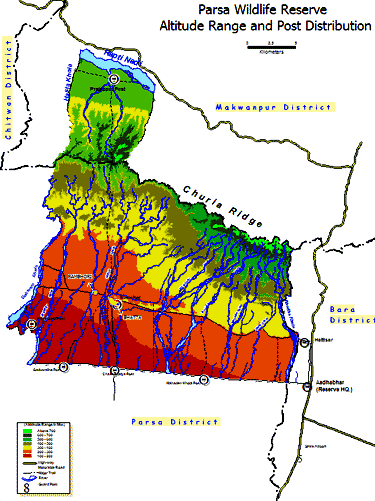 Parsa
Wildlife Reserve occupies parts of Chitwan,
Makawanpur, Parsa and Bara districts in central
Nepal. The reserve headquarters is situated
at Adabar on the Hetauda-Birgunj highway and
the Reserve covers 499 sq. kms. and established
in 1984.
Parsa
Wildlife Reserve occupies parts of Chitwan,
Makawanpur, Parsa and Bara districts in central
Nepal. The reserve headquarters is situated
at Adabar on the Hetauda-Birgunj highway and
the Reserve covers 499 sq. kms. and established
in 1984.
The dominant landscape of the
reserve, the Churiya hills ranging from 750m.
to 950m. run east-west of the reserve. The reserve
has sub-tropical monsoon climate. The forest
is composed of tropical to subtropical forest
types with sal constituting 90% of the vegetation.
In the Churiya hills Chir pine grows and along
the stream and rivers Khair, Sissoo with silk
cotton tree occur. Sabai grass a commercially
important grass species grows well in the southern
face of Churiya hill. The reserve supports a
good population of resident wild elephant, tiger,
leopard, sloth bear, gaur, blue bull, wild dog.
Other common animals are sambar, chital, hogdeer,
barking deer, langur, striped hyena, ratel,
palm civet, jungle cat etc.
There are nearly 300 species of
birds in the reserve. Giant hombill, peafowl,
red jungle fowl, flycatchers, woodpeckers etc.
are few other common birds found in the reserve.
Many kinds of snakes like king cobra, common
cobra, krait, rat snake, pythons are found in
the reserve due to hot tropical climate.
CLIMATE
Winter (October-December) provide pleasant temperatures
with clear skies. Night time temperatures can
drop to 0°C. During spring (January-March)
temperatures rise and water becomes scarce.
During summer (April-June) the days become hot
and humid with temperatures rising up to 40°C.
Monsoon (July-September) brings cooling rains.
FEATURES
The soil is primarily composed of gravel and
conglomerates, making it susceptible to erosion.
The hills present a very rugged face with numerous
gullies and dry streambeds. As the foothills
are very porous, water flows underground and
surfaces at a distance of about 15 km. from
the hills base. The Churia hill range from 750m
to 950m running east to west.
FLORA AND FAUNA
The forests are mainly composed of tropical
and subtropical species. Sal forests compose
about 90 percent of the Reserve's vegetation.
Along the banks of the rivers, riverine forests
are found containing species like Khair and
Silk cotton tree. In the north-eastern part
of the Reserve, at higher altitudes, Sal and
Pine forests occur. On the southern slope of
the Siwalik hills, the forests are dominated
by pine. Sabai grass a commercially important
species, grows well on the southern face of
the Churia hills.
The Reserve supports good populations
of endangered species such as wild Asian elephant,
Royal Bengal tiger, sloth bear, and leopard.
blue bull, wild dog , sambar deer, spotted deer,
hog deer, barding deer, langur, rhesus macaques,
striped hyena, jungle cat, and palm civet.
The Reserve also provides habitat
for more than 500 species of birds. For example
white breasted kingfisher, paradise flycatcher,
large racquet-tailed drongo, golden backed woodpecker,
are some of the common sights. Giant hornbill,
one of the endangered bird species is found
here. The Reserve is also famous for reptiles
and different kinds of snakes including common
cobra, common and banded krait, rock python
and King cobra.
PLACES OF INTEREST
Near the Reserve headquarters is a machan (view
tower) that provides excellent opportunities
for game viewing. Kailash Bhata is atop a hill,
and is of religious importance. It houses two
small temples (Dugdeswor Mahadev) paying homage
to the Hindu gods of Shiva and Parvati. Also,
one can have a panoramic view of the lush terai
forest from here. An elephant camp is located
near Amlekhgunj. Jungle rides can be arranged
from the Reserve headquarters, which is the
best way to get a close view of wildlife.
FACILITIES
There is a small guesthouse with four rooms
at the headquarters. There is also a teahouse
that can provide tea, snacks, and Nepali food.
Hetauda and Birgunj are about an hour's drive.
Modest shops have also come up near Pathlaiya
which is a walking distance from Headquarters.
Make sure to bring a first-aid kit containing
medicines for intestinal problems.
HOW TO GET THERE
The Reserve is easily accessible. The Kathmandu
- Hetauda - Birgunj highway passes by the entrance
gate. Bus can be availed from Kathmandu. It
takes six to seven hours to get there. A flight
to Simara takes about 15-20 minutes, from where
it hardly takes 15 minutes to reach the Reserve
headquarter by vehicle.